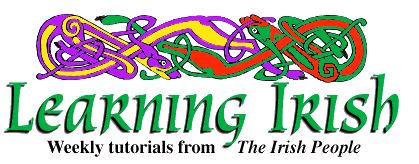
Irish Lesson 44
|
Pronunciation Review We will review the vowel "u" this week. When the "síneadh fada" (SHEEN-uh FAH-duh) mark is over it, making it ú, its sound is usually that of (oo), as in English "food" or "rude", but the Irish sound is held longer. Examples: lúb (loob); gúna (GOON-uh); dúnaim (DOON-im). Without a síneadh fada, "u" between consonants often has the sound (u), as in English "put", "foot", or "should. Examples: gunna (GUN-uh); thug (hug); guthán (gu-HAW*N). The (uh) sound, as in English "run", "love" "but", is less common for "u" in Irish. Irish speakers often substitute other sounds for (uh) in English, as you have learned in previous lessons. You may have heard the last three words above pronounced (run, lohv, boht) instead of (ruhn, luhv, buht). Nevertheless, some Irish words have the (uh) sound or a sound close to it. Examples: dul (duhl); agat (uh-GUHT); doras (DUH-ruhs). The (uh) sound is common in unaccented syllables, of course, such as in garda (GAHR-duh) or córas (KOH-ruhs). In "ua", the "u" can be pronounced (oo), as in: crua (KROO-uh); nuachtan (NOO-uhk*-taw*n); buail (BOO-il). In the west and north, "ua" may be pronounced (oh) in some words, such as "rua", red-haired. An example: Eoghan Rua (OH-uhn roh) Ó Néill, anglicized as Owen Roe O'Neill. At the beginning of a word, "ua" may sound like (oo) or (woo-uh). Try: uachtar (OO-uhk*-tuhr) and uaim (oo-WIM). In the latter word, the sounds may run together so that they sometimes resemble (wim), but in any case, the word should be pronounced without a pause between the parts of the pronunciation.
Grammar
Forms such as: He said that they were there They think that it is not here We heard that you bought a house are called indirect speech. Here are examples which are translations of the sentences above: Dúirt sé go raibh siad ansin (DOO-irt shay* goh rev SHEE-uhd un-SHIN). Síleann siad nach bhfuil sé anseo (SHEEL-uhn SHEE-uhd nahk* VWIL shay* un-SHUH). Chualamar gur cheannaigh tú teach (K*OOL-uh-muhr gur HYAN-ee too TAHK*). For the present tense, use "go" or "nach" after the first verb. "Go" introduces an affirmative statement, and "nach" a negative. The first verb can be affirmative I say, you think, etc., or negative, such as: I don't think. It can also ask a question: An ndeir (ner) tú go bhfuil sé anseo?, Do you say that he is here? When "tá" is the second verb, it is in the "bhfuil" form either "go bhfuil" or "nach bhfuil". Both "go" and "nach" eclipse. Study these examples: Cloisim go mbaineann sé a chóta de (KLISH-im goh MWIN-uhn shay* uh K*OH-tuh de), I hear that he takes his coat off. Deir sé nach gceannaíonn sé mórán bia (der shay* nahk* gyan-EE-uhn shay* moh-RAW*N BEE-uh), he says that he doesn't buy much food. Ní shíleann sí go ndíolann Seán leabhair (nee HEEL-uhn shee goh NEEL-uhn shaw*n LOU-wir), she doesn't think that John sells books. Ní dóigh liom go n-ólann siad mórán bainne (nee DOH-ee luhm goh NOHL-uhn SHEE-uhd moh-RAW*N BAHN-ye), I don't think that they drink much milk.
Note that when a vowel starts the second verb, you must put an "n" before the vowel, as in "go n-itheann sé" or "nach n-itheann sé".
Drill
Make up a sentence for each of the following combinations: Deir sé (der shay*) with: go bhfaigheann sí (goh VWEYE-uhn shee), and nach bhfaigheann sí; go nglanann siad (gohng LUHN-uhn SHEE-uhd), and nach nglanann (nahk*-ung LUHN-uhn) siad; go léann sé, and nach léann sé; go míníonn (meen-EE-uhn) sé and nach míníonn sé. Cloisim with: go níonn sé (goh NEE-uhn shay*), and nach níonn sé; go n-itheann sí, and nach n-itheann sí; go bpósann siad (goh BOHS-uhn SHEE-uhd), and nach bpósann siad; go rithimid, and nach rithimid. Is dóigh liom with: go scríobhann sé, and nach scríobhann sé; go dtéann sé, and nach dtéann sé; go dtagann sé, and nach dtagann sé.
Conversation
Mairsile (MAHR-shil-e):Dia dhuit, a Stiofáin (DEE-uh git, uh shtee-FAW*-in). Hello, Stephen. Stiofán (shtee-FAW*N): Dia's Muire dhuit, a Mhairsile (DEE-uhs MWIR-uh git, uh VWAHR-shil-e). Conas tá tú inniú? Hello, Marcella. How are you today? Mairsile: Tá mé go han-mhaith (goh HAHN-uh VWAH). Agus conas tá tú féin? I am very well. And how are you yourself? Stiofán: Táim go maith leis. Cloisim go bhfuil tú ag foghlaim Gaeilge arís (uh FOU-lim GAY*-li-ge uh-REESH). I am well, too. I hear that you're studying Irish again. Mairsile: Ó, táim tar éis bheith á foghlaim le fada. Sílim go bhfuil mé ag dul chun cinn anois, (oh, TAW*-im tuhr ay*sh ve aw* FOU-lim luh FAH-duh. SHEEL-im go vwil may* uh duhl hun kin uh*NISH). Oh, I'm after studying it for a long time. I think that I am making progress now.
Notes: "Duit" can become "dhuit" (git) in much speech. "dh" before "u" sounds much like English "g" in "go". "Táim tar éis bheith (ve)" comes into English as "I am after _____ ", meaning "I have been ____ ". An example is: "Táim tar éis bheith teacht abhaile", meaning "I have come home".
(c) 1998 The Irish People. May be reprinted with credit. |